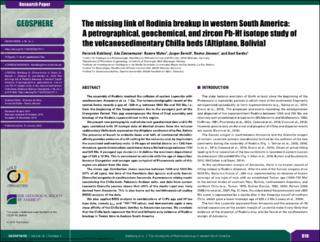| dc.contributor.author | Bahlburg, Heinrich | |
| dc.contributor.author | Zimmermann, Udo | |
| dc.contributor.author | Matos, Ramiro | |
| dc.contributor.author | Berndt, Jasper | |
| dc.contributor.author | Jimenez, Nestor | |
| dc.contributor.author | Gerdes, Axel | |
| dc.date.accessioned | 2023-02-08T09:54:38Z | |
| dc.date.available | 2023-02-08T09:54:38Z | |
| dc.date.created | 2019-12-19T23:17:32Z | |
| dc.date.issued | 2020 | |
| dc.identifier.citation | Bahlburg, H., Zimmermann, U., Matos, R., Berndt, J., Jimenez, N., & Gerdes, A. (2020). The missing link of Rodinia breakup in western South America: A petrographical, geochemical, and zircon Pb-Hf isotope study of the volcanosedimentary Chilla beds (Altiplano, Bolivia). Geosphere, 16(2), 619-645. | en_US |
| dc.identifier.issn | 1553-040X | |
| dc.identifier.uri | https://hdl.handle.net/11250/3049182 | |
| dc.description.abstract | The assembly of Rodinia involved the collision of eastern Laurentia with southwestern Amazonia at ca. 1 Ga. The tectonostratigraphic record of the central Andes records a gap of ∼300 m.y. between 1000 Ma and 700 Ma, i.e., from the beginning of the Neoproterozoic Era to the youngest part of the Cryogenian Period. This gap encompasses the time of final assembly and breakup of the Rodinia supercontinent in this region.
We present new petrographic and whole-rock geochemical data and U-Pb ages combined with Hf isotope data of detrital zircons from the volcanosedimentary Chilla beds exposed on the Altiplano southwest of La Paz, Bolivia. The presence of basalt to andesite lavas and tuffs of continental tholeiitic affinity provides evidence of a rift setting for the volcanics and, by implication, the associated sedimentary rocks. U-Pb ages of detrital zircons (n = 124) from immature, quartz-intermediate sandstones have a limited range between 1737 and 925 Ma. A youngest age cluster (n = 3) defines the maximum depositional age of 925 ± 12 Ma. This is considered to coincide with the age of deposition because Cryogenian and younger ages so typical of Phanerozoic units of this region are absent from the data.
The zircon age distribution shows maxima between 1300 and 1200 Ma (37% of all ages), the time of the Rondônia–San Ignacio and early Sunsás (Grenville) orogenies in southwestern Amazonia. A provenance mixing model considering the Chilla beds, Paleozoic Andean units, and data from eastern Laurentia Grenville sources shows that >90% of the clastic input was likely derived from Amazonia. This is also borne out by multidimensional scaling (MDS) analysis of the data.
We also applied MDS analysis to combinations of U-Pb age and Hf isotope data, namely εHf(t) and 176Hf/177Hf values, and demonstrate again a very close affinity of the Chilla beds detritus to Amazonian sources. We conclude that the Chilla beds represent the first and hitherto only evidence of Rodinia breakup in Tonian time in Andean South America. | en_US |
| dc.language.iso | eng | en_US |
| dc.publisher | Geological Society of America | en_US |
| dc.rights | Navngivelse 4.0 Internasjonal | * |
| dc.rights.uri | http://creativecommons.org/licenses/by/4.0/deed.no | * |
| dc.title | The missing link of Rodinia break up in western South America: A petrographical, geochemical, and zircon Pb-Hf isotope study of the volcanosedimentary Chilla beds (Altiplano, Bolivia) | en_US |
| dc.type | Peer reviewed | en_US |
| dc.type | Journal article | en_US |
| dc.description.version | publishedVersion | en_US |
| dc.rights.holder | The authors | en_US |
| dc.subject.nsi | VDP::Matematikk og Naturvitenskap: 400 | en_US |
| dc.source.pagenumber | 619-645 | en_US |
| dc.source.volume | 16 | en_US |
| dc.source.journal | Geosphere | en_US |
| dc.source.issue | 2 | en_US |
| dc.identifier.doi | 10.1130/GES02151.1 | |
| dc.identifier.cristin | 1763195 | |
| cristin.ispublished | true | |
| cristin.fulltext | original | |
| cristin.qualitycode | 1 | |

